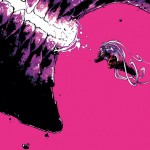 Ed. note – Ahead lies a blood soaked tale, rife with blood, sacrifice, and spoilers. You’ve been warned.
Ed. note – Ahead lies a blood soaked tale, rife with blood, sacrifice, and spoilers. You’ve been warned.
Glory #33 is the penultimate issue in Joe Keatinge and Ross Campbell’s sadly abbreviated relaunch. Why only 12 issues? Keatinge had this to say when asked about it by Comics Alliance back in December:
Sometimes, what you start off doing and what you end up doing are two different things. When I first came on, even before I had an artist, I wanted to have a massive story that went on for 70 issues, but the combination of actually working with Ross and, it’s so cliché to say it but it’s so true, the characters kind of take over sometimes. In this situation, it wasn’t really as grandiose a story as I initially thought as much as it was a story about the relationship between these two different people, Riley and Gloriana, and how they each affect these huge and small situations. When we really started re-plotting things out as it went along, after the 12th issue, without saying too much, it would become a totally different book. So maybe we should just leave the party early before our welcome’s worn out and tell this one story that seems to be what it’s about anyway.
Glory was shaping up to be an epic war story with a complex plot line spanning across the reaches of time, gorgeously drawn by Ross Campbell. Having now read issue 33 and seeing where the story is going, I get what he’s saying about the characters taking over. Riley and Glory’s relationship is the thread that ties the tale together, but I do still wonder, perhaps selfishly, if maybe Keatinge and Campbell are leaving the party a little too early.
The Thule, led by Glory’s father, demonic Lord Silverfall, are on the brink of extinction. A legendary force known as a Knight of Thule has arisen. It will not stop until it has destroyed all in its path. Glory, recently reunited, albeit awkwardly, with her parents, has assembled a counter force comprised of the majority of the heroes from the Image/Extreme Studios universe, including the Youngblood team and Supreme. It’s an uneasy alliance. Supreme, Image’s answer to Superman, is on-board because he wants to fight to defend the helpless civilians caught in the crossfire of the throw down. He is quite clear with Glory that he doesn’t trust her or have any faith in her ability to lead.
As the battle rages, friends and allies fall, either as casualties or thralls to the Knight. Glory takes a team of seven of her strongest fighters to take the Knight head-on, leaving Riley to help the civilians on the ground. While fighting the Knight, Glory’s sister, Nanaja, is the first to fall. Supreme loses patience with Glory’s battle tactics. The ensuing argument turns physical. If you’ve ever wondered what might happen if Wonder Woman and Superman ever threw down…well, ok, that might not necessarily be answered here, but Superman might just want to think about watching his back anyway. Glory turns her brutal, demonic rage from Supreme to the Knight, unleashing a well of power to defeat her foe. Unfortunately, it is at the expense of what remains of her humanity. Riley realizes this and makes an unthinkable sacrifice in a bid to save Glory from herself.
The results of Riley’s decision are most likely what Keatinge is referring to when he says the characters took over from where he originally wanted to go with his story. Riley and Glory cannot recover from this issue’s ending, and they are the crux of this series. I understand why he’s pulling the trigger; I just don’t believe he had to do it now. Fans of Glory and Riley will find the ending of this issue devastating. Over the space of a few arcs, tiptoeing up to this ultimate resolution while trying to find other solutions, Riley’s choice would have been, perhaps, that much more emotionally affecting.
Ross Campbell’s art work continues to be outstanding. His depiction of Glory’s sheer mass in comparison to the others around her is more than imposing; it is as though she is a planet leading her orbiting moons into battle. The small moments with character interactions are as thoughtful and expressive as the action sequences are dynamic, making those character moments pop that more vividly. Wherever Campbell ends up after Glory ends its run with the next issue, he will be a talent to watch.
Keatinge and Campbell have set a high standard with this short run on Glory. They’ve demonstrated that any character, even one originally conceived as a Wonder Woman knock-off for a cheesecake T and A book in the 90s, can be rehabilitated and used to tell a meaningful story. I will be sad to see it end, but happy to relive the stories as they come out in trades.
 Podcast RSS Feed
Podcast RSS Feed iTunes
iTunes Google Play
Google Play Stitcher
Stitcher TuneIn Radio
TuneIn Radio Android
Android Miro Media Player
Miro Media Player Comics Podcast Network
Comics Podcast Network